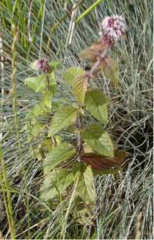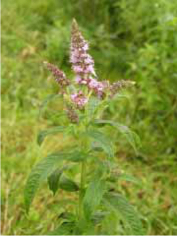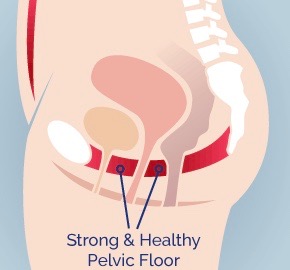Some useful information of a common herb:
Common name: Wild Mint
Proper name: Mentha longifolia
With its strong peppermint aroma and taste, this herb has found its way into homes for centuries where it has been used in the kitchen and as a medicine. There are many different mints; different species, hybrids and special selections that grow all over the world. Most of them are water lovers and are usually found growing in wet and damp places.
Description
Mentha longifolia or wild mint is a fast growing, perennial herb that creeps along an underground rootstock. In Lesotho it can reach a high of 30 to 50 cm. Strongly aromatic, the leaves are formed in pairs opposite each other along the square-shaped stem. The soft, lanceolate leaves (long and narrow with a sharp point) are 3 – 4 cm long and 7 – 20 mm broad. The leaves are usually coarsely hairy and the edges sparsely toothed. The colour of the leaves varies from light and dark green to greyish-green. The small flowers of Mentha longifolia are produced in dense clusters on tall, branched, tapering spikes in a variety of colours from white to mauve. This wild mint flowers in mid to late summer (November to April).
Distribution
Two mint species are indigenous to South Africa, Mentha longifolia and M. aquatica (wild water mint).
Both are quite commonly found in marshes and along streams, from the Cape through Africa and Europe. M. longifolia (longifolia meaning long leaves) is identified by its stalkless leaves and white to mauve flowers in dense clusters on a tall spike. The leaves of M. aquatica (aquatica meaning living in water) are broader and more egg-shaped, whereas the flowerheads are roundish whorls (approx. 25 mm in diameter), pink or mauve flower clusters formed one above the other. Two commonly found types in Lesotho are: Balderjan and Spearmint.
Uses and cultural aspects
Found in most parts of the country and easy to harvest, wild mint is a popular traditional medicine. It is mainly used for respiratory ailments but many other uses have also been recorded. It is mostly the leaves that are used, usually to make tea that is drunk for coughs, colds, stomach cramps, asthma, flatulence, indigestion and headaches. Externally, wild mint has been used to treat wounds and swollen glands.
The following well known natural treatment of traditional Basotho medecine is highly effective at the beginning of an upcoming flue:
A mixture of dried leaves of Koena and Phefo (one cup of each) is boiled in half a bucket of water. As that water cools down the person is washing the whole body with this hot and smelling water and should immediately cover herself with warm blankets and rest for a good nights sleep. Koena is also very effective for steam inhalations.
A bunch of Koena hanging somewhere in the house keeps away flies and mosquitoes.
Growing Koena
With its strong fragrance and many uses, it is worth finding a place in the garden for the wild mint. Mentha longifolia is easy to grow, with the same requirements as most mints. Mints are fast growers but seem to be always on the move. With underground runners, they disappear and pop up wherever they find a suitable spot. Heavy feeders and water lovers, mints grow in semi-shade and full sun. They do well in pots where they are contained, but need to be repotted every year or two in new compost-rich soil. Placing the pot under a tap is a good way of catching the small drips and leaks while keeping the mint moist. To encourage new fresh growth, mint should be cut back often. Mint is easy to multiply by division; the smallest piece of healthy rootstock quickly grows into a new clump with regular water and compost. Cuttings of young actively growing shoots root easily throughout the year.
Harvesting and drying Koena
Ideally we collect the clean leaves before the plant blooms. Lets choose a place where no animals are grasing or passing by to make sure that the plants are not contaminated. The leaves shall be dried in the shadow where there is enough of ventilation. A practical way to dry a big amount of leaves is: – take a clean bedsheet, put all the leaves to dry on it, tie the two corners on each side together and hang the sheet inside of the hut onto beams of the roof. The first few days move the leaves to make sure that all the leaves will dry. The dried leaves can be stored in paperbags or in a pillowcase in a dry and clean place in the house. On a piece attached to the bag write the date and the place of the harvest. Keep the leaves not longer than one year. Leftovers from the year before can be put on the compost side.




